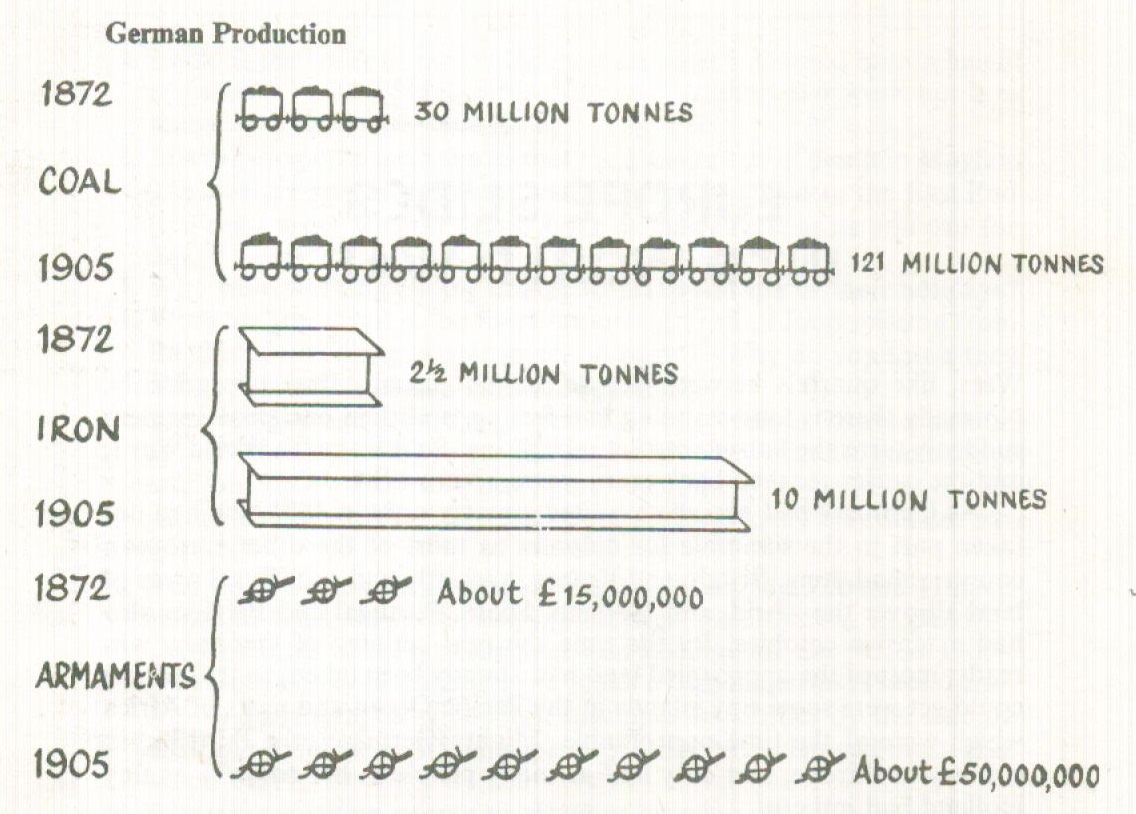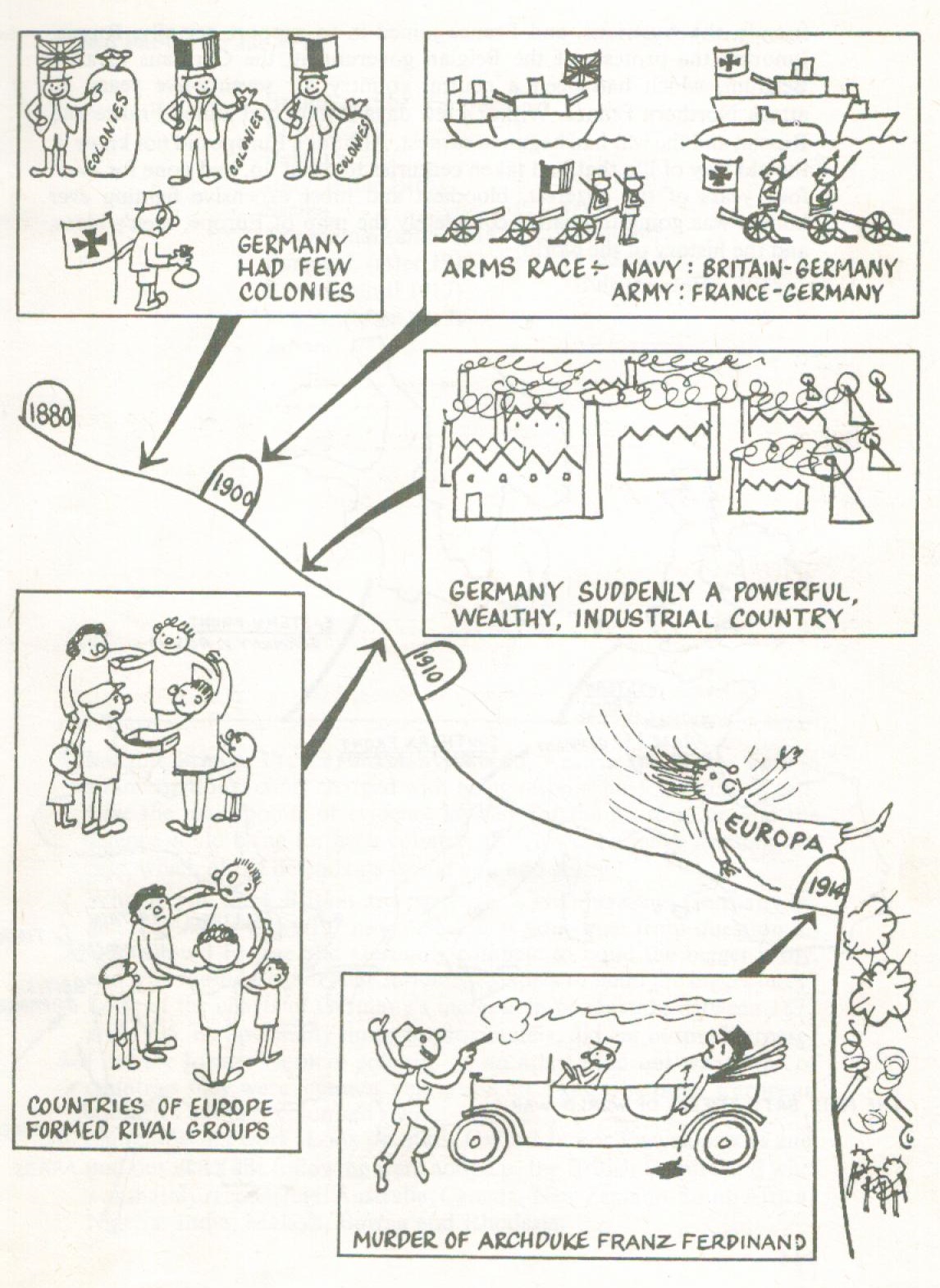|
Wars, like quarrels between people, do not usually flare up suddenly. Normally there is long-standing bad-feeling, and then one small incident
suddenly turns the hatred into actual fighting. So it was with World War 1,
and the causes reached back many years before 1914.
As Germany had become a united country only in 1871, she had not
taken part in the scramble for colonies as most of the other European
countries had done. Britain and France especially had seized vast areas of
land all over the world, and Holland, Spain, Portugal and Belgium also
had extensive colonies. By the time the new country of Germany was
ready, most of the unoccupied land had already been taken, so that all she
could get were some tiny islands in the Pacific Ocean and parts of Africa
which were at the time unprofitable. Mighty Germany, the third largest
country in Europe, had only half as many people in her colonies as tiny
Holland had in hers.

In the last twenty-five years of the nineteenth century Germany had
become a great industrial country, with great coal mines, chemical works
and factories turning out every type of product, but especially ships, engines, machinery and weapons. This meant there was great rivalry for
trade, particularly with Britain who had half a century's start in industry
and was well established in the foreign markets. Production of everything
in Germany soared.

From the beginning of the century there was a race in armament building for the war which most people thought was bound to come sooner or
later. France and Germany struggled to outdo each other in the size of
their armies, the number of guns and the strength of their fortresses, while
Britain and Germany raced to build the bigger navy. Bigger, faster and
more-heavily armed ships followed one after another in the effort to win
command of the seas when war came.
The Treaty of Versailles was not an openly' negotiated peace since neither
Germany nor Austria were allowed to negotiate. There was no free, open and
impartial settlement of colonial claims. The final settlement suffered
therefore from the obvious contradictions between the idealism of the 'Fourteen
Points' and the practical arrangements which were possible in the Europe of the
post-war years. Even the sacred principle of national
self-determination which was applied, set up problems of new national minorities
which were just as difficult and dangerous as the old.
Meanwhile, the countries of Europe were taking sides and forming alliances. Germany, Austria and Italy (who later changed sides) formed the
centre of one group: Russia and France were the centre of the rival group. Although Britain did not actually sign a treaty as the other countries had
done, it was fairly certain that in the event of war she would help France
and Russia. The scene was now set for the showdown : the two heavily
armed groups were ready for war. Germany thought that Russia might be
the weak link on her enemies' side, for Russia had been badly defeated by
Japan in 1905 and looked ready for a revolution. All Germany needed was
an excuse, and in June, 1914, this was given to her.
An Austrian prince, Archduke Franz Ferdinand, was shot dead in his
car while on a visit to the small Austrian possession of Bosnia, which was
friendly with Russia. Almost without waiting for an explanation, Austria,
who feared Serbian attempts to wrest Bosnia from her, attacked Serbia, who
called to her ally, Russia, for help. Germany declared war to help her
friends, the Austrians, and France joined in to support her ally, Russia. Ignoring the protests of the Belgian government, the Germans invaded
Belgium, which had been a neutral country for seventy-five years, to
attack Northern France. Within a few days Britain had joined France and
Russia, and the war had begun in earnest. Although Europe did not know it,
the old way of life that had taken centuries to build up, had gone for ever:
four years of the bitterest, bloodiest and most expensive fighting ever
known was going to change completely the map of Europe, men's ideas,
and the history of the world.

QUESTIONS
1. Imagine Britain, France, Germany, Russia, Austria and Serbia were in
an international court charged with being responsible for World War 1. Give the main points of evidence lawyers for the prosecution and the
defence could bring for each country. If you were a judge deciding the
case, which of the defendants would you find guilty?
2. Why do you think Britain was particularly anxious when Germany began to build a powerful navy? (Look at your map from question 1.)
3. Why should France and Germany compete to build the bigger army,
and why should Britain and Germany compete to build the bigger navy?
4. Look at the charts of Germany's increase in production between 1872
and 1905. By how many times, approximately, did her output increase?
5. Find the former German colonies on an atlas. Find out what kind of
countries they were (climate, vegetation etc.) and why other European
countries had not colonised them.
| |